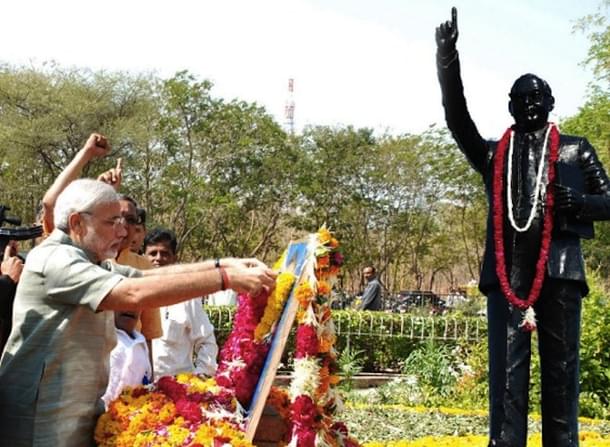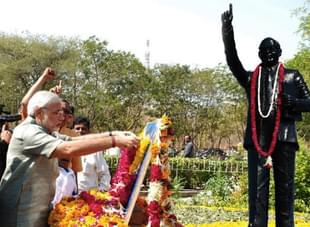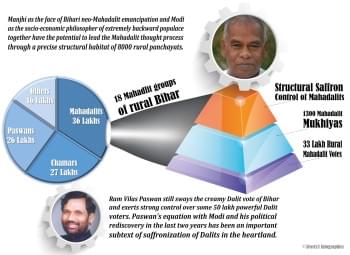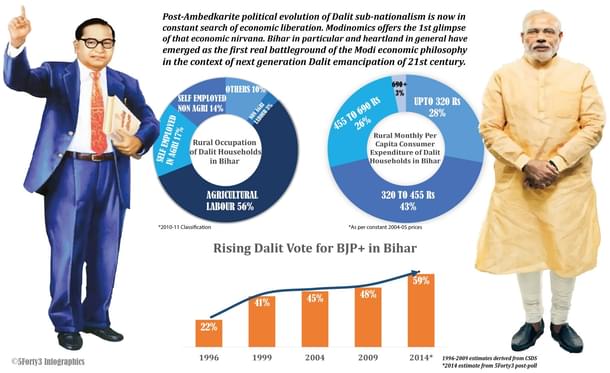Politics
Dalit Sub-Nationalism And The Rise Of Modi–The Bihar Chapter
Praveen Patil
Aug 12, 2015, 12:32 PM | Updated Feb 11, 2016, 09:55 AM IST
Save & read from anywhere!
Bookmark stories for easy access on any device or the Swarajya app.


Explaining the shift of Dalits in Bihar towards Modi.
In 1971, the biggest impact of “Garibi Hatao” was on the Dalits who arguably comprised the poorest sections of Indian society. Congress party had been steadily losing base with each passing election and there was even a split in 1969 which should have logically eroded its base further. But Indira Gandhi managed to reverse the trend in 1971 by targeting the Dalit vote through her anti-poverty slogans.
For the first time since 1957, Ms Gandhi actually managed to increase the Congress vote-share by 3% and seat share from 283 to 352 Congress parliamentarians.
Yet, Dalits of north India were the ones who bore the maximum brunt of Emergency excesses of forced sterilizations and slum clearance schemes. So, when Babu Jagjivan Ram walked out of the Congress party just before the 1977 elections, he came to symbolize the ‘Dalit anger against Indira Gandhi’.
Despite, Babu Jagjivan Ram’s antecedents in Bihar, it was Uttar Pradesh that was home to the original Dalit socio-political emancipation in north India. We often make the mistake of identifying Kanshi Ram as the progenitor of Dalit political rise in UP. The truth is that Ambedkarite Dalit social movements predated Kanshi Ram in cities like Kanpur and Lucknow.
In fact, most Ambedkarite Dalit organizations, active at the grassroots level even today, trace their origins to two core movements – Dalit Panthers and BAMCEF of the 70’s vintage.
Most of these social organizations have consciously avoided direct electoral politics, unlike the BSP. The rise and fall of Mayawati in the last decade (from being the CM of UP to winning zero seats in 2014 LS polls) can be attributed, at least partially, to her process of alienating a whole host of such Dalit social organizations.
The BSP, when it was in power failed to nurture the Dalit ecosystem and instead was busy in expanding base to Brahmins and Muslims which resulted in the 2014 drift of Dalit voters away from Maya and towards BJP.
Rise of Modi disrupts the Left-leaning narrative of Dalits
Possibly for the first time since 1971, Dalit imagination was fired to such an extent by the Modi campaign of 2014, nationally, cutting across geographies. In fact, silently, it has been the Dalit voter who has come to be the mainstay of the BJP from UP to Maharashtra to Haryana – both in the national as well as state elections (the one election where Dalits did not choose BJP as their primary choice was in Delhi where the party faced a huge setback this year).
This saffronization of Dalits has neither been widely reported in the media nor have the Dalit intellectual elite come to terms with this phenomenon. So it is a largely unheralded demographic shift finding little space in the Indian academic research field controlled by the left.
Indeed, saffronization of Dalits sits at complete contrast to the post-Ambedkar intellectual evolution of the Dalit elite which strongly advocated socio-economic Marxism and politico-religious counter-Hinduism. This is where the rise of Narendra Modi—from an extremely backward caste—as the leader of the Hindu thought process has proved to be the great disruption to the trajectory of a carefully ordained path to various backward social groups by the emphatically left-leaning Indian intelligentsia.
We have already widely absorbed this disruption in the Mandal polity but are yet to digest the Dalit story fully.
As already elucidated, unlike Uttar Pradesh, Bihar had mostly remained outside the purview of Ambedkarite social movements of the 1970’s and 80’s. In fact, for a very long time, the Bihari Dalit vote had failed to find an independent voice of its own and kept changing tracks – Ram Vilas Paswan had come to symbolize this constantly shifting Dalit mindset of Bihar.
The advent of JDU-BJP alliance, especially after the separation of Jharkhand, transformed the Dalit landscape of Bihar forever.
Dalit vote becomes a perfect antidote to ‘secularism’ politics for BJP
Just like the Muslim vote in Bihar, the Dalit vote is also a monolith with little sub-regional and economic diversions. In fact, the Dalit vote is emerging as a perfect antidote for secularism politics which had created an artificial threshold for BJP to surpass in order to win an election because Muslims would all vote unidirectionally with the sole purpose of defeating the saffron candidate.
Since 2014, BJP has mostly nullified the Muslim vote by garnering Dalit support to cross the electoral threshold and then winning the contest by uniting large sections of Upper Caste and OBC populace. Demographic realities of Bihar elections this year have once again made the Dalit vote crucial for BJP and NDA to cross the artificial threshold being set by the 1 crore odd Muslim votes.
There are six very powerful reasons why the Dalit romance with Modi is likely to continue in Bihar this Diwali.
The first reason is that of the saffron organizational structure. Nitish Kumar is often credited for the social engineering of extremely backward Dalits by inventing the powerful sociological term – Mahadalit. But the facts are a little at variance. Yes, Nitish Kumar as the CM of Bihar nurtured the Mahadalit platform, but this was a long-standing social experiment of the Sangh and the BJP in Bihar. In fact, one of the lesser known truths is that Sushil Modi, as the deputy CM, was instrumental in convincing Nitish to provide special sub-caste reservations to Mahadalits at the Panchayati Raj level administrative mechanism which actually empowered this group of extremely backward voters.
Thus, at the grassroots level, an ordinary BJP worker is more attuned to the Mahadalit emancipation story than an average JDU worker which is why Nitish Kumar embarked on the failed Manjhi experiment after realizing that the Mahadalits had mostly abandoned him in 2014 following the split with the BJP.
The second reason is that of the Mahadalit political structure. The 18 poorest sub-sects who form the Mahadalits number at around 36 lakh voters of whom a vast majority of 33 lakhs reside in the rural areas. There are some 1,300 Mahadalit Sarpanchs (or Mukhiyas) out of a total of some 8,000 Panchayats (at the rate of 16% reservation). These 1300 Mahadalit Mukhiyas between them can overwhelmingly influence the 33 lakh rural Mahadalit voters with each Mukhiya catering to at least 5 nearby Panchayats.
This precise structural habitat is what makes the Mahadalit vote a single controllable organism which can directly impact the election results in some 35-40 assembly segments.
Not only does BJP have a favourable equation with most of these Mahadalit Mukhiyas but also because of a strategic partnership with former CM Jitan Ram Manjhi it is more likely that the 2014 shift of Mahadalits to Modi would continue even in the Bihar assembly election.
In last month’s Bihar legislative council elections from local bodies, this link between NDA and the Mahadalit representatives was clearly visible as the saffron alliance managed to win 13 out of 24 MLC seats.

The third reason is that of politically industrious leadership. Dominant Dalit sub-castes of Chamars and Dushads (Paswan) each account for 27 lakh and 26 lakh votes respectively while Pasi and Dhobi community make up the rest of the 16 lakh odd Dalit votes of Bihar.
Again an overwhelming majority of more than 90% of all these Dalit groups are spread across the rural landscape of Bihar. It is here in the villages that Dalits face the actual brunt of class dominance.
One of the unwitting consequences of Mandalization of polity in the heartland is the dramatic alteration of rural landscape which was once dominated by upper castes but has now become a playground of dominant OBCs like Yadavs and Kurmis.
This is one of the lesser analyzed reasons why Dalits and upper castes are showing increasing tendencies of coming together in the heartland which had created a surprising coalition of interests in support of Mayawati and BSP in Uttar Pradesh.
Dalits have borne the maximum brunt of Mandal hegemony in a state like Bihar, and this goes beyond the social domain to also have an economic impact.
For instance, take the case of the Lohar community traditionally involved in vessels and utensils making activities who are not only facing social ostracization by powerful Yadavs and Kurmis but are also out of work due to availability of cheap Chinese goods.
Today, a Modi-led BJP has assumed the political leadership of a coalition of interests of such marginalized Dalits in rural heartland by creating a neo-economic doctrine. What is more, by roping in the tallest Paswan leader into the NDA fold, BJP has sent a clear and successful signal to all the dominant Dalit castes to unite behind Modi’s leadership in Bihar.
The fourth reason is that of an economic hope. Around 60% of the rural Dalit households in Bihar subsist by being labourers which is the primary reason why 70% of the Dalit rural households spend less than Rs 455 per capita every month for consumption which even by Bihari standards is almost 60% below the average MPCE of rural Bihar.
This stark economic reality has to be internalized to understand the Dalit mindset. For instance, all of you who are reading this article spend more money to simply access internet every month than an average Bihari Dalit spends for his entire monthly consumption cycle!
This average Bihari Dalit does not own land to worry about Land Bill in the Parliament instead hopes that Modi would build more roads in rural Bihar and set up more industries in Bihar where he can go and get gainful employment.
This average Bihari Dalit voter is more than willing to make common cause with a BJP-led NDA because he can easily correlate to Modi’s economic vision.
The fifth reason is that of choice. It is indeed true that Bihari Dalits have been supporting NDA for almost a decade now, at times going against even Ram Vilas Paswan. Nitish had raised the hope of Dalits (just like all sections of Bihari society) by providing a better governance model for the first time in this extremely backward state.

In the last two years though, the Nitish model has drifted away while the Modi model has become attractive. In the October election, for the average Dalit voter of Bihar there are only two choices – NDA and Nitish Kumar.
The difference must be stressed here, while NDA as a group is a clear choice, Nitish is the choice only as an individual, for Dalits are still fearful of Lalu Prasad Yadav and have no affinity for Congress. This is the reason why Nitish as a choice has limitations because JDU would be a viable force only in some 70-80 seats while NDA is a clear choice in almost all the seats.
The sixth and final reason why the saffronization of Dalits may continue in Bihar is a generic electoral reality of today. Post-caste electorate of India is an invention of our times where voters have clearly identified goals of good governance and development.
As of today, Modi still remains the tallest icon for this post-caste generation of India and the Bihari Dalit is no exception to that rule. In fact, with Lalu and Congress on the other side, it may actually become easier for Bihari Dalits to choose Modi, supported by Paswan and Manjhi.
As the campaigning for Bihar builds up, media will invariably flaunt the arithmetic of JDU-RJD-Congress alliance and the lethality of Muslim vote vis-à-vis the BJP, but Bihari Dalits may once again come to Modi’s rescue to overcome the Muslim threshold.
This is an interesting demographic crossroad for the historically poor communities of India symbolized by new found hope. Elections in India not only produce winners and losers but also give us the best possible snapshot of demographic change. Bihar election this winter will add an important chapter to the history of Dalit sub-nationalism.
Analyst of Indian electoral politics and associated economics with a right-of-centre perspective.





